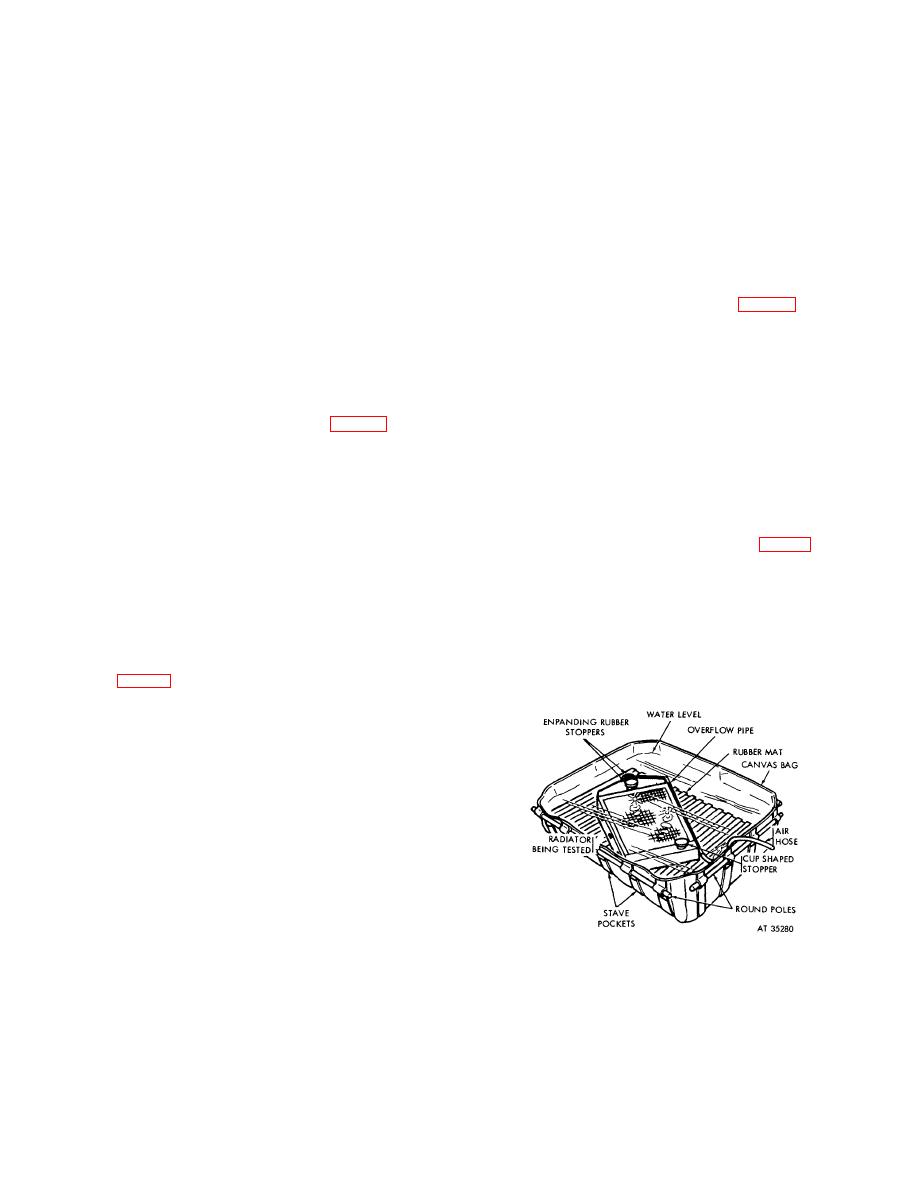 |
|||
|
|
|||
|
Page Title:
Testing Radiator Caps |
|
||
| ||||||||||
|
|
 NOTE
After all leaks have been repaired, the radiator should be
painted. A non-insulating paint should be used. Before
The appearance of air bubbles in thermostat
painting, the radiator should be clean, dry and free of all
housing will indicate a leak.
flux residue.
(6) Repeat procedure on all cylinders until all
leaks are located.
NOTE
(7) When air pressure-hissing indicates the
cylinder valves are open, the engine should be rotated until
No more than one coat of paint will be applied to
valves are closed.
radiator cores on tactical wheel vehicles (3/4 ton
c. Testing with Automatic Transmission. This test
through 10 ton trucks), except M39A2 series
trucks, which will not be painted.
should be performed with engine cold. As engine-heats,
water expansion could result in appearance of bubbles
when there is no leak. This test will not locate the leak but
3-24.
Testing Stand
only determine if a leak exists.
(1) Disconnect fan belt from water pump.
The radiator test and repair stand (8, fig. 2-1) combines
(2) Remove thermostat and fill thermostat
leak test tank, work bench and soldering equipment into
opening with water.
one efficient unit It has a motor driven work bench rack for
(3) Operate engine for a short time and
raising and lowering the radiator at the test tank with
observe for air bubbles in thermostat housing while engine
minimum effort. When the rack is elevated above the tank
is running.
water, it becomes a sturdy adjustable work bench.
Soldering torch, air blow gun and regulated air connections
testing, a Combustion Leak Tester (5, fig 2-1) is also
are built in. Specially designed jigs for supporting the
recommended. This tester can be used on all types of
radiator in any position are attached to the unit. This well-
vehicles and operates on a chemical color change
designed arrangement promotes an organized systematic
indication It requires only the removal of the radiator cap
repair procedure with a saving of time and effort.
and will locate the leak with the removal of each spark
plug wire in sequence.
3-25.
Field Test Tank
3-22.
Testing Radiator Caps
For field service a collapsible canvas tank (fig 3-9) will be
provided in the third echelon equipment unit set No 1 for
Radiator caps should be tested periodically for proper
light maintenance companies. This tank consists of a one-
operation. A defective cap can cause loss of coolant,
piece canvas bag with wooden staves in pockets to hold
over-pressure damage or collapse of cooling system
the sides up and four round poles running through canvas
components. When testing radiator caps, the pressure
loops to support the rim. A rubber mat protects the bottom
seal on both the cap seating surface and the radiator filler
of the tank from being torn by the radiator. When the tank
neck should be carefully inspected. A cooling system
is collapsed, two poles are removed and placed inside the
tester (2, fig 2-1) should be used. These testers make use
tank, which is then rolled inside the mat and fastened with
of a hand pump, a pressure gauge and adapter fittings for
five flat metal hooks
attaching to the various types of caps. The radiator cap
seals should be moistened to assure that the test results
are equal to operating conditions. To determine the
pressure relief valve opening pressure, the manufacturer's
specifications should be consulted In some instances, the
pressure is stamped on the cap. Be sure that the cap
operates at the specified pressure.
The vacuum
protection valve can be tested by visually checking that the
valve spring operates and the seal is good.
3-23.
Cleaning and Painting
CAUTION
Radiators should never be painted with ordinary
lacquers, enamels or paints as these insulate the
heat transfer. This reduces the cooling efficiency.
Figure 3-9. Collapsible canvas tank.
Always use Non-Insulating Radiator Core Paint.
3-9
|
|
Privacy Statement - Press Release - Copyright Information. - Contact Us |